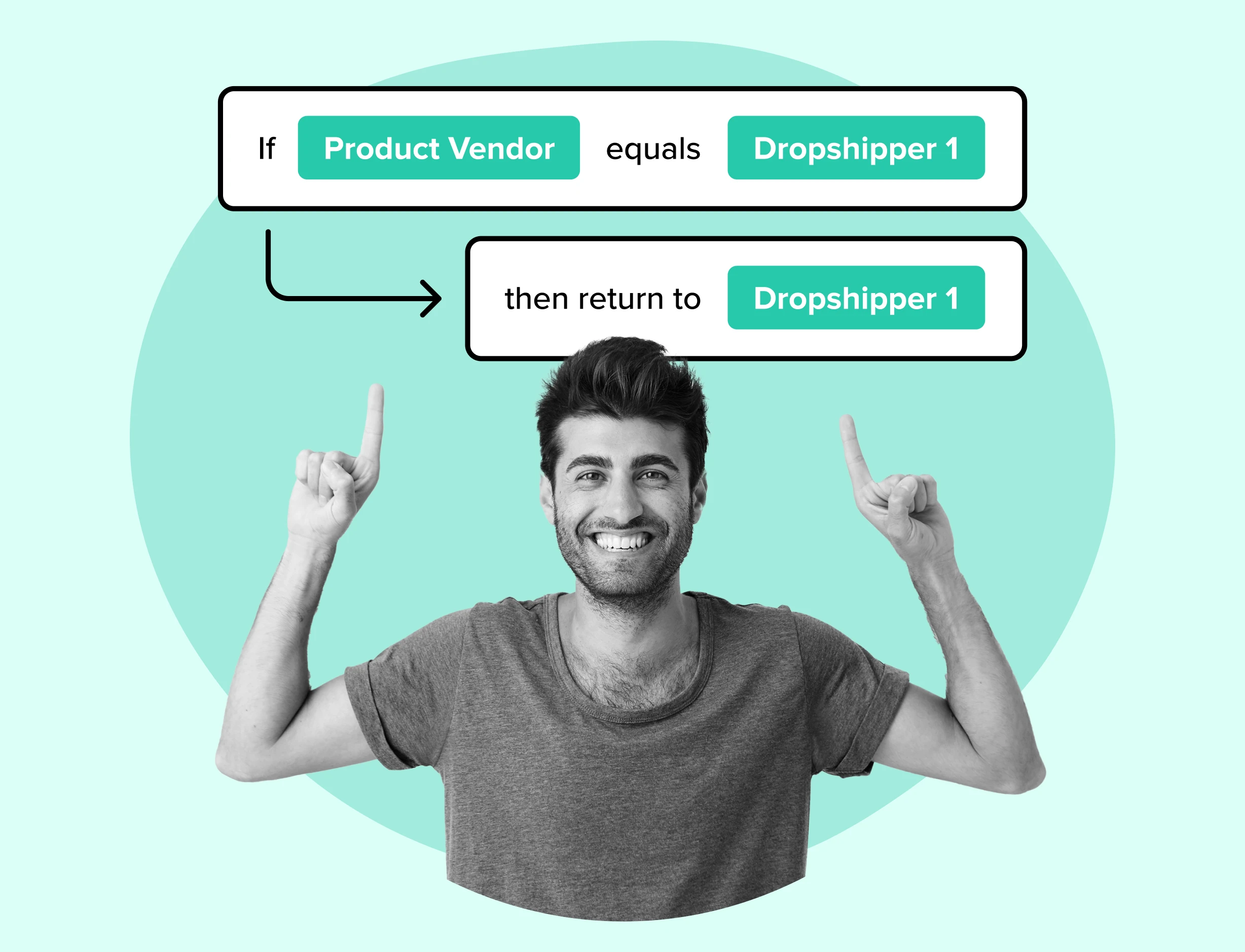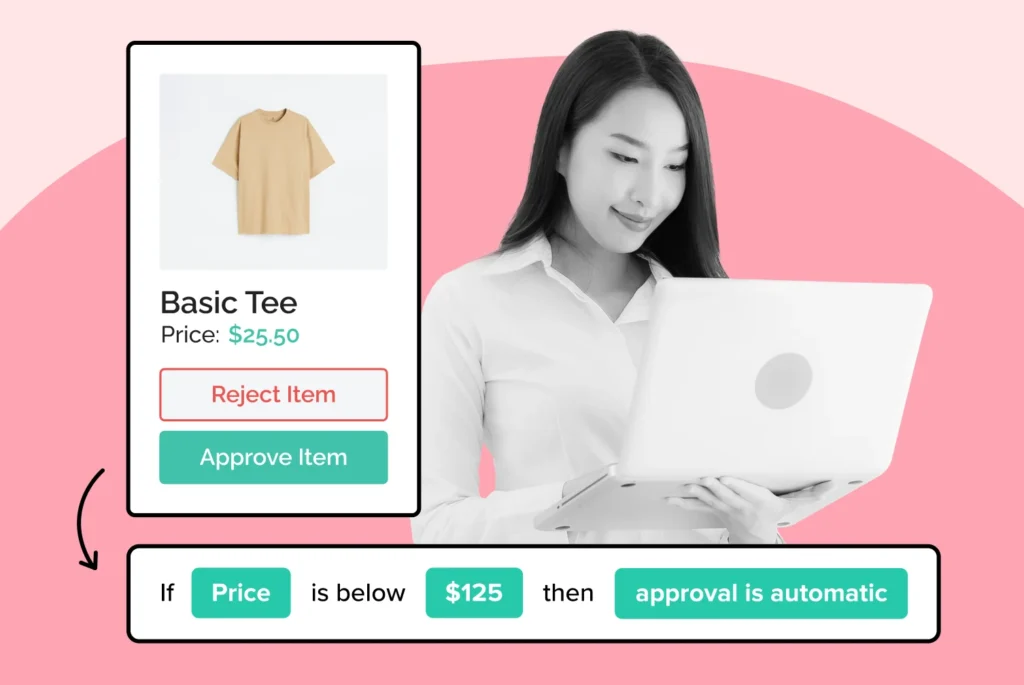
Top 7 Ecommerce Shipping Mistakes to Avoid
This guide distills the crucial mistakes that could be undermining your eCommerce success and equips you with the insights to avoid them!
Shipping, Tracking & Notifications
Boost customer experience and reduce support tickets
Realtime order and shipment tracking
Proactive order and shipping notifications
AI-Enhanced Discounted Labels
Predictive pre-purchase estimated delivery dates
Self-Serivce branded order tracking
Effortless experience delivered
Identify and Resolve Order Issues
Realtime order and shipment tracking
Make returns profitable and delight customers
Flexibility to define any return destinations & conditions
Simplify returns for your customers and team
Incentivize exchanges over returns
Returns management made easy for your team
Returns management made easy for your team
Easy claims and smart upsells
Understand why your customers are returning
In-Store & Curbside Pickup
Unify the online and the in-store experience
Hassle-free pickup experience for customers
In-Store dashboard to keep operations streamlined
In-Store and Online orders unified
Drive foot-traffic to your stores
Shipping, Tracking & Notifications
Boost customer experience and reduce support tickets
Realtime order and shipment tracking
Proactive order and shipping notifications
AI-Enhanced Discounted Labels
Predictive pre-purchase estimated delivery dates
Self-Serivce branded order tracking
Effortless experience delivered
Identify and Resolve Order Issues
Realtime order and shipment tracking
Make returns profitable and delight customers
Flexibility to define any return destinations & conditions
Simplify returns for your customers and team
Incentivize exchanges over returns
Returns management made easy for your team
Returns management made easy for your team
Understand why your customers are returning
In-Store & Curbside Pickup
Unify the online and the in-store experience
Hassle-free pickup experience for customers
In-Store Dashboard to keep operations streamlined
In-Store and Online orders unified
Drive foot-traffic to your stores
Boost customer experience and reduce support tickets
Realtime order and shipment tracking
Proactive order and shipping notifications
AI-Enhanced Discounted Labels
Predictive pre-purchase estimated delivery dates
Self-Serivce branded order tracking
Effortless experience delivered
Make returns profitable and delight customers
Flexibility to define any return destinations & conditions
Simplify returns for your customers and team
Incentivize exchanges over returns
Returns management made easy for your team
Equip your team for precise return checks.
Easy claims and smart upsells
Understand why your customers are returning
Unify the online and the in-store experience
Hassle-free pickup experience for customers
In-Store Dashboard to keep operations streamlined
In-Store and Online orders unified
Drive foot-traffic to your stores
Find the answer to all your questions
Take a step by step trip through our functionality to see how we can improve your ecommerce processes.
Explore the most comon questions about WeSupply
Calculate the ROI that WeSupply can bring you
Read actionable articles on how to optimize your post-purchase experience and decrease support tickets
Get inspired by stories of how our customers implemented an effortless post-purchase experience
Wondering if WeSupply is a good fit for you? Read through our use cases to see how we can help you increase conversion & improve CX!
A Deep Dive into Top Companies' Order Tracking & Returns Strategy
Find the answer to all your questions
Explore the most comon questions about WeSupply
Calculate the ROI that WeSupply can bring you
Request a no strings attached review of your current shopping experience and missed conversion opportunities
Take a step by step trip through our functionality to see how we can improve your ecommerce processes.
Read actionable articles on how to optimize your post-purchase experience and decrease support tickets
Get inspired by stories of how our customers implemented an effortless post-purchase experience
A Deep Dive into Top Companies' Order Tracking & Returns Strategy
Wondering if WeSupply is a good fit for you? Read through our use cases to see how we can help you increase conversion & improve CX!

Interested in how dropshipping in ecommerce unlocks new entrepreneurial opportunities? By connecting retailers directly with suppliers, this strategy bypasses traditional inventory challenges, reduces costs, and scales swiftly. This article demystifies dropshipping, offers clear steps for getting started, and divulges expert tactics for thriving in online retail – all without the overhead of a stocked warehouse.
Dropshipping is an order fulfillment method that allows entrepreneurs to start online stores without holding inventory, relying on suppliers to handle storage, packaging, and shipping.
Key to dropshipping success is choosing reliable suppliers, optimizing the e-commerce platform and user experience, managing customer relations effectively, and implementing effective financial and returns management systems.
Dropshipping faces challenges such as competition, market dynamics, and logistics complexity, but strategic planning and embracing market trends can lead to long-term profitability and resilience in the e-commerce space.
WeSupply streamlines e-commerce and dropshipping with key features like a branded returns portal, self-service returns with QR codes, dynamic tracking, and tailored notifications. Its flexible returns policies, smart dropshipping returns management, and extensive integrations simplify operations, enhance customer satisfaction, and improve efficiency. Boost your e-commerce efficiency. Get Started with WeSupply for a seamless dropshipping experience.
Dropshipping is an order fulfillment method that is transforming the e-commerce landscape. In this model, you, as an online retailer, don’t have to stock the products you sell. Instead, when a customer places an order from your e-commerce store, your dropshipping supplier takes care of storing, packing, and shipping the products directly to your customer. This model is attractive to entrepreneurs due to its efficiency and low overhead, although it may come with trade-offs in customer experience.
The beauty of this model is its simplicity and flexibility. With minimal upfront investment, you can start a dropshipping business that has the potential to grow and evolve with market trends. This flexibility has made dropshipping increasingly popular, offering entrepreneurs an exciting opportunity to start businesses with minimal risk, making it one of the most attractive business models among other business models.
In a dropshipping business, there are two primary models for sourcing products:
1. Finding Suppliers Yourself: You search for suppliers independently using online databases like AliExpress, Worldwide Brands, or SaleHoo. Once you find a suitable supplier, you can add their products to your online store and market them to potential customers. This model requires more time and effort, as you are directly managing supplier relationships.
2. Using a Supplier-Connected App: Platforms like Shopify’s DSers app streamline the process by connecting you with a network of suppliers. You simply browse products, add them to your store, and when a customer places an order, the supplier handles the fulfillment process. This method automates much of the dropshipping workflow, making it easier to manage.
Despite its simplicity, dropshipping still requires careful planning and effort to succeed. It is not a get-rich-quick model, but with dedication, it can become a reliable way to run a scalable online store.
At its core, the dropshipping model involves three key players: the retailer (or the dropshipper), the supplier, and the customer. As a dropshipper, you run an online store where you market and sell products. You don’t handle the physical products. Instead, you work with a dropshipping supplier who stores, packs, and ships the products directly to your customers. Your profit comes from the difference between the retail price you set for the customer and the wholesale price you negotiate with the supplier.
Despite the simplicity of this model, it’s crucial to understand the roles and responsibilities of each player to ensure the smooth operation of your dropshipping business.
The success of a dropshipping business rests on the relationship between the dropshipper, suppliers, and customers. As a dropshipper, you are the link between the supplier and the customer. You manage the online store, market the products, handle customer service, and ensure a smooth shopping experience for your customers. Your customers, on the other hand, expect a seamless shopping experience. Even though you don’t handle the physical logistics, your customers will hold you responsible for any fulfillment issues, making your choice of supplier crucial to maintaining customer loyalty.
The dropshipping supplier plays a vital role in this triad. They manage the logistics of storing, packaging, and shipping the products to the customer on your behalf. Having a reliable and trustworthy supplier is therefore crucial for your dropshipping business. You need to carefully select your dropshipping suppliers based on their reliability, manufacturing capabilities, communication skills, and customer service reputation. A good supplier can make the difference between a satisfied customer and a lost sale.
Navigating the dropshipping ecosystem requires a clear understanding of the roles and responsibilities of each player. As a dropshipper, your primary roles include:
Marketing the products
Managing sales
Ensuring customer communication and support
Setting the product prices
Being responsible for sales tax.
The supplier, on the other hand, is responsible for:
maintaining inventory
order fulfillment
packing
shipping items directly to the buyer
They are the behind-the-scenes player who ensures that the products get to the customers safely and on time.
Meanwhile, the customers, typically unaware of the dropshipping arrangement, expect to receive quality products within a reasonable time frame. They look to you, the dropshipper, for customer service and satisfaction. Balancing the needs and expectations of all parties is crucial for the smooth operation of your dropshipping business, especially when managing customer orders.
Now that we’ve covered the theory behind dropshipping, let’s move into the practical aspects of setting up and running a dropshipping business. This involves:
Understanding the dropshipping process
Setting up your e-commerce store
Choosing the right platform and suppliers
Managing customer relationships
In this section, we’ll walk you through these steps, providing a step-by-step guide to help you navigate this journey with confidence.
The dropshipping process involves a relationship between a customer-facing store, known as the dropshipper, and a supplier. This model allows the dropshipper to sell products without needing to keep them in stock. As a dropshipper, you:
Market products on your online store
When a customer places an order, you pass the order details to your supplier
The supplier ships the product directly to the customer
You don’t have to handle the products yourself or worry about storing and shipping inventory.
There are several ways you can connect with suppliers for your dropshipping business. You can find wholesale suppliers directly through online databases, or you can use apps like DSers that connect stores to thousands of suppliers. These tools make it easy for you to find products to sell and automate the fulfillment process, making it easier and more efficient for you to run your dropshipping business.
Setting up your e-commerce store is the first step towards starting your dropshipping business. You can use platforms like Shopify to set up your dropshipping store. Shopify offers a platform for dropshipping businesses which includes setting up an online store, choosing a theme, and customizing the store to fit the brand. Once you have your store set up, you can import products to your Shopify store for dropshipping through the DSers app, which connects to AliExpress.
While setting up your e-commerce store, there are several things you need to consider. These include:
Choosing a business structure for legal and tax considerations
Setting up business bank accounts and credit cards to separate your personal and business finances
Checking local laws and regulations to see if you need a local business license
Doing these things can help ensure that your business is set up legally and correctly from the start.
Choosing the right platform for your dropshipping business is crucial for its success. There are several platforms available, each with its own features and benefits. For instance, Shopify offers a complete commerce platform that allows you to build a dropshipping e-commerce store, sell in multiple places, and easily manage products and payments. On the other hand, DSers is a popular tool for dropshipping with Shopify, allowing users to import products from AliExpress and manage orders efficiently.
While Shopify and DSers are great options, there are also other platforms available. For example, you can also dropship on platforms like Amazon, eBay, and Etsy, allowing for greater reach and diversification of sales channels. The key is to choose a platform that suits your business needs and can help you effectively manage your dropshipping business.
Once you have set up your dropshipping business, the next step is to implement strategies that can help you achieve excellence. This involves:
Optimizing your web design and user experience
Selecting and managing suppliers effectively
Crafting a customer-focused strategy
Implementing an effective returns management system
In this section, we’ll delve into these strategies, providing you with practical tips and insights to help you achieve success in your dropshipping business.
Your website is your shop front in the world of e-commerce. It’s the first thing your customers see, and it’s what they base their first impressions on. Therefore, having a well-designed website with a user-friendly interface is crucial for your dropshipping business. Good UX design determines the user’s feelings towards a product and has a significant impact on a brand’s bottom line.
To optimize your website for success, focus on eliminating friction for users. This involves understanding your audience and addressing their needs. Use a simple design with ample white space and minimal text to make it easy for users to process information. Also, ensure that your typography and text hierarchy aids in users’ comprehension and enables them to scan information quickly and effectively.
Regular usability testing, including A/B testing and heat mapping, can help you continually improve your UX design through market research.
Selecting the right supplier is critical to your dropshipping business. The supplier you choose will have a direct impact on your product quality, delivery times, and overall customer satisfaction. Therefore, it’s crucial to choose your suppliers carefully based on their reliability, manufacturing capabilities, communication skills, and customer service reputation.
But choosing the right supplier is just the first step. Once you’ve selected a supplier, you need to manage your relationship with them effectively. This involves:
Communicating your expectations clearly
Monitoring their performance regularly
Addressing any issues promptly
Nurturing your relationship with the supplier
Working together to enhance the customer experience.
By managing your suppliers effectively, you can ensure a smooth operation for your dropshipping business and maintain high levels of customer satisfaction.
Crafting a customer-focused dropshipping strategy is essential for the success of your business. This involves:
Understanding your customers’ needs and expectations
Providing a seamless shopping experience
Collecting meaningful information about your customers
Addressing their needs throughout their shopping journey
To create a customer-centric strategy, engage every team member in customer interactions, such as through rotating support schedules, to foster a company-wide customer-centric culture. Also, personalize the customer experience by using targeted communications based on customer purchase history to increase customer loyalty and retention rates.
Remember, being customer-centric means pleasing customers at every interaction across their path to purchase. By crafting a customer-focused dropshipping strategy, you can increase customer satisfaction, loyalty, and ultimately, your business’s profitability.
WeSupply elevates dropshipping strategies and returns management to new heights, providing an indispensable toolkit for businesses aiming to enhance customer satisfaction and streamline operations. Through a branded returns portal, WeSupply fosters customer loyalty by offering a personalized, omnichannel experience that avoids the confusion of third-party courier systems. With its self-service returns process, autogenerated QR code return labels, comprehensive returns tracking, and tailored post-purchase communication, WeSupply ensures a seamless, frictionless returns experience. Moreover, its capability to create flexible returns rules and smart dispositions simplifies returns logistics, catering to diverse customer needs and operational demands. Furthermore, WeSupply’s robust integration capabilities allow it to connect seamlessly with hundreds of third-party tools, enhancing operational efficiency and customer experience.
Key Features:
Self-Service Returns Process: Empowers customers with control over returns, saving businesses time.
Autogenerated QR Code Return Labels: Simplifies the return process, eliminating the need for printing.
Returns Tracking: Provides customers with the ability to track their returns easily.
Post-Purchase Notifications: Utilizes high-engagement email & SMS notifications to keep customers informed and engaged.
Flexible Returns Rules: Offers customizable returns policies to fit various use cases, including smart return rules and intelligent dispositions for physical returns.
Dropshipping Returns Management: Features intelligent disposition functionality for seamless returns to original vendors, supporting unlimited dropshippers with specific policies and fees.
Integrations: Boasts extensive integration capabilities, connecting order and returns data to a wide range of API-driven tools for enhanced customer experiences and cost savings.
Order Tracking: Display the estimated delivery date, tracking information, and shipment updates
Proactive Order and Shipping Notifications: Keep customers informed with updates on their orders to prevent unnecessary inquiries. Notify customers promptly about shipping delays or changes.
Estimated Delivery Date: Address shipping anxiety by clearly communicating when orders are expected to arrive. Displaying estimated delivery dates on the product page, cart, and checkout.
Logistics Analytics: Stress on analytics and data-driven decisions to improve operations. Utilize CSAT and NPS to refine the customer experience.
Order Flow Analytics: Offer detailed analytics for understanding and optimizing order management. Include data on orders received, shipped, canceled, and delivered.
Unlock the full potential of your returns process and enhance your customer’s post-purchase journey. Book a demo with WeSupply today and see how easy and efficient your returns can be!
Auto Rim Shop revolutionized their customer support by automating delivery and returns for heavy items like car rims and tires, which are often shipped from various dropshippers. By implementing WeSupply, they addressed challenges like split shipments, return logistics, and real-time tracking, drastically reducing support tickets and enhancing customer satisfaction. The platform enabled precise return label generation, split shipment visibility, and automated notifications, streamlining processes for both the company and its customers. Dive into the full case study to explore how Auto Rim Shop shifted gears to drive customer satisfaction and efficiency to new heights!
Understanding the financial aspects of dropshipping is essential for managing your business effectively and ensuring profitability. This involves understanding costs, profits, and the economics of dropshipping, managing your finances effectively, and mastering profit margins for sustainable growth.
In this section, we’ll delve into these aspects, providing you with the knowledge and tools to navigate the financial landscape of dropshipping with confidence.
One of the key advantages of dropshipping is its cost-effectiveness. Unlike traditional retail, dropshipping does not require a significant upfront investment in inventory. However, this does not mean that dropshipping is free from costs. As a dropshipper, you need to understand the costs involved in running your business, including:
Supplier services
Shipping
Taxes
Platform fees
Marketing
While understanding costs is important, it’s equally important to understand profits. Your profit in dropshipping comes from the difference between the retail price you set for the customer and the wholesale price you negotiate with the supplier. On average, dropshipping businesses operate with a profit margin of 15–20%. However, profit margins can vary depending on several factors, including your business model, niche, and the types of products you sell.
Effective financial management is crucial for the success of your dropshipping business. This involves regularly analyzing your financial performance, managing your cash flow effectively, and reducing expenses strategically. To help with this, you can leverage automated dropshipping accounting software, which can save time, reduce errors, and provide real-time financial insights.
In addition to managing your finances, it’s also important to plan for the future. This involves using financial planning tools to create cash flow projections and monitor your financial performance. You should also seek professional guidance from financial advisors or business consultants to get tailored strategies and improve your cash flow management practices.
By keeping a close eye on your finances and planning ahead, you can ensure the financial health of your dropshipping business.
Profit margin is a key indicator of a business’s financial health. It’s a measure of how much profit you make for each dollar of sales. In dropshipping, the typical profit margin ranges between 15-20%. However, reaching and maintaining these profit margins requires careful financial management and strategic planning.
To master profit margins in dropshipping, you need to understand your costs and set your prices accordingly. This involves calculating your costs, including the cost of goods sold (COGS), operating expenses, and taxes, and setting your prices to cover these costs and leave a profit margin. You also need to monitor your profit margins regularly and adjust your prices as needed to maintain profitability.
By mastering profit margins, you can ensure the sustainable growth of your dropshipping business.
WeSupply transforms the returns process into a strategic advantage, significantly boosting ROI by reducing operational costs and increasing customer loyalty. By streamlining returns and leveraging smart integrations, businesses can offer a seamless, branded returns experience, encouraging repeat purchases and positive word-of-mouth.
Speed up returns process
Book a quick call with our experts to see how WeSupply’s self-service returns makes it super easy for your customers to return anything, anytime – without needing to submit customer support tickets or call in!
Enhanced customer satisfaction and operational efficiency translate directly into improved profitability. Discover the potential impact on your bottom line. Use our ROI Calculator now and see how much you could save and earn with WeSupply!
Low Overhead Costs: Since you don’t need to purchase inventory upfront or manage a warehouse, your startup costs are low. Your primary expenses will be marketing and running your website.
Location Independence: You can run your dropshipping business from anywhere in the world, making it perfect for entrepreneurs who want a flexible, location-independent lifestyle.
Risk-Free Testing: Dropshipping lets you test different products without a significant financial commitment. If a product doesn’t perform well, you can easily remove it from your store and try something else.
Strong Supplier Network: Building relationships with reliable suppliers opens doors for future business ventures and product expansion. Suppliers can support your growth by offering new products, better prices, and faster shipping options.
Like any business model, dropshipping comes with its own set of challenges. These include managing competition and market dynamics, handling inventory and shipping complexities, and protecting your brand reputation and customer loyalty.
In this section, we’ll address these challenges and provide solutions to help you navigate the dropshipping landscape successfully.
The dropshipping industry is highly competitive, with many businesses selling similar products. To stand out from the competition, you need to differentiate your brand and offer unique value to your customers. This can involve building a strong brand identity, offering high-quality products, and providing excellent customer service.
In addition to managing competition, you also need to navigate the dynamic market conditions in dropshipping. This involves staying informed about market trends, understanding your competitors’ strategies, and adapting your business to changing market conditions. By staying agile and responsive, you can effectively manage competition and market dynamics and ensure the success of your dropshipping business.
One of the key challenges in dropshipping is handling inventory and shipping complexities. Even though you don’t hold the inventory yourself, you still need to ensure that your suppliers have the products in stock and can ship them to your customers promptly. This requires effective inventory management, including the use of automated stock monitoring tools and working with multiple suppliers.
Shipping is another complex aspect of dropshipping. As your supplier is responsible for shipping the products to your customers, you need to ensure that they can do so quickly and efficiently. This involves choosing reliable suppliers, setting clear shipping policies, and communicating these policies to your customers. By mastering logistics, you can ensure a smooth shopping experience for your customers and enhance your brand reputation.
WeSupply simplifies dropshipping challenges, particularly in inventory and shipping, by enabling restocking during returns and offering robust integrations. This approach streamlines operations, improves customer satisfaction, and reduces costs by connecting seamlessly with numerous third-party tools and couriers.
Key Features:
Extensive Integrations: Seamlessly integrates with hundreds of third-party tools and couriers, connecting order and returns data to existing API-driven tools for an enhanced customer experience and operational savings.
See the difference for yourself! Book a demo with WeSupply now and streamline your dropshipping operations like never before.
Your brand is your business’s most valuable asset. It reflects your business’s identity and values, and it’s what sets you apart from your competitors. Therefore, protecting your brand reputation and sustaining customer loyalty is crucial for your dropshipping business.
To protect your brand, you need to:
Ensure that your products meet high quality standards
Provide top-notch customer service
Operate ethically and transparently
Strive to be socially responsible
Provide a seamless shopping experience for your customers, from browsing products to checking out and receiving their orders.
By building a trustworthy brand and prioritizing exceptional customer service, you can retain your customers and build long-term loyalty.
Once you’ve mastered the basics of dropshipping, you can start implementing advanced strategies to take your business to the next level. This involves:
Building strong relationships with suppliers
Selecting the right products
Providing comprehensive product information
Adapting to high-volume orders
In this section, we’ll delve into these advanced strategies and provide practical tips to help you take your dropshipping business to new heights.
Just like any other business, dropshipping involves various legal considerations, making it essential to ensure your dropshipping legal compliance. You need to:
Secure a general business license that complies with local regulations and zoning laws.
If you’re selling products in jurisdictions that impose sales tax, you’ll also need to secure a sales tax permit, which allows you to collect and remit taxes on behalf of the government.
If you’re involved in international trade, you need to understand import and export regulations and secure the necessary licenses.
In addition to these legal requirements, you also need to respect intellectual property rights when selecting products to sell. And you must comply with consumer protection laws, which involve ensuring product quality and safety, providing accurate product descriptions, and having transparent warranty and return policies. By navigating these legal considerations, you can ensure that your dropshipping business operates legally and ethically.
The structure of your business determines how you pay taxes and your level of personal liability. As a dropshipper, you need to understand your tax obligations, including collecting and remitting sales tax as per jurisdictional requirements and reporting and paying income tax on profits.
In addition to understanding your tax obligations, you also need to choose the right business structure for your dropshipping business. You can operate as:
a sole proprietor
a partnership
a limited liability company (LLC)
a corporation
Each structure has its own legal and tax implications.
By understanding taxation and choosing the right business structure, you can lay a solid legal foundation for your dropshipping business.
The rise of conscious consumerism has brought supply chain transparency and ethical sourcing to the forefront of e-commerce. Consumers today want to know where their products are coming from and whether they are made ethically and sustainably.
As a dropshipper, it’s your responsibility to ensure that your suppliers adhere to ethical sourcing practices and provide transparency in their supply chain. This may involve:
Choosing suppliers who engage in eco-friendly manufacturing practices
Selecting suppliers who possess environmental certifications
Requesting details on the origin of materials and production processes from your suppliers
By taking these steps, you can ensure that your business aligns with ethical and sustainable practices.
By embracing supply chain transparency and ethical sourcing practices, you can align your dropshipping business with consumer values and market trends, enhancing your brand reputation and customer loyalty.
Evaluation is a key part of any business strategy. By evaluating the success of your dropshipping business, you can:
Identify areas of strength and areas that need improvement
Gauge your performance against industry benchmarks
Stay informed about recent trends and future opportunities.
In this section, we’ll provide an overview of the current state of dropshipping and discuss the key metrics and trends that can help you evaluate your dropshipping success.
The dropshipping industry has seen significant growth over the years. In fact, the global dropshipping market size is expected to reach $301.11 billion in 2024, up from $243.42 billion in 2023. This growth is driven by several factors, including:
The increasing use of smartphones and e-commerce platforms
The rising popularity of online shopping
The flexibility and scalability of the dropshipping model
In terms of market segments, the fashion segment is expected to see robust growth, with a compound annual growth rate (CAGR) of 35.6% by 2031. This is driven by customer demand for branded products and the convenience of online shopping. At the same time, the use of sustainable and eco-friendly products is becoming a significant selling point in dropshipping, reflecting the increasing expenditure on sustainable goods and services.
Looking ahead, there are several trends and opportunities that dropshippers can tap into. The increasing popularity of social media and influencer marketing, particularly among millennials, Gen Z, and Gen X, is shaping how products are discovered and could provide future opportunities for dropshippers. In fact, the #TikTokMadeMeBuyIt trend on TikTok suggests that social networks will continue to strongly influence online consumption habits, pointing to new avenues for dropshipping promotions and sales.
In terms of product categories, the following are expected to see strong growth in the coming years:
Home automation and smart home devices
Electronic gadgets
Fashion and apparel
Home decor
Kitchen gadgets
Beauty and personal care products
Sports and fitness products
Educational toys and hobbies
By staying informed about these trends and opportunities, you can adapt your dropshipping business to meet changing consumer demands and tap into new growth opportunities.
As we’ve seen, dropshipping offers an exciting opportunity for entrepreneurs to start and grow their own dropshipping business with minimal upfront investment and risk. While the dropshipping model simplifies the process of starting an online business, it requires careful planning, strategic decision-making, and continuous learning to achieve long-term success.
Whether you’re just starting your dropshipping journey or looking to take your existing business to the next level, the knowledge and strategies covered in this blog post can guide you on the road to dropshipping mastery. So, are you ready to embrace the opportunities in dropshipping and navigate the future of e-commerce with confidence? Let’s get started!
Building a resilient and profitable dropshipping business involves:
Setting up an online store
Listing products for sale
Understanding the dropshipping process
Selecting the right products and suppliers
Managing customer relationships effectively
To build a resilient and profitable dropshipping business, you need to:
Master marketing strategies
Understand and use data analytics
Build strong relationships with your suppliers
Select a niche that isn’t overly saturated and can provide a unique value proposition to your customers
By focusing on these areas, you can build a resilient and profitable dropshipping business that can withstand market fluctuations and grow sustainably.
Looking ahead, the future of ecommerce business, particularly in e-commerce and dropshipping, looks promising. With the continued growth of online shopping and advancements in technology, there are numerous opportunities for dropshippers to innovate and grow. However, along with these opportunities come challenges that require strategic planning and effective decision-making.
To navigate the future of e-commerce with confidence, it’s important to:
Stay agile and adaptable
Stay informed about market trends, regulatory changes, and consumer preferences
Adapt your business to meet these changing demands
Maintain strong relationships with your suppliers
Provide exceptional customer service
Stay committed to ethical practices and sustainability
By embracing these practices, you can navigate the future of e-commerce with confidence and position your dropshipping business for long-term success.
In conclusion, dropshipping presents an exciting opportunity for entrepreneurs to start and grow an online business with minimal risk and investment. By understanding the dropshipping process, selecting the right products and suppliers, optimizing your web design and user experience, and managing your finances effectively, you can build a resilient and profitable dropshipping business. However, like any business model, dropshipping comes with its own set of challenges. But by staying informed, adaptable, and customer-focused, you can navigate these challenges and set your business on the path to success. So, are you ready to embrace the exciting world of dropshipping? The future of e-commerce awaits!
WeSupply revolutionizes e-commerce for dropshipping by offering a comprehensive solution that enhances customer satisfaction and streamlines returns management. Its suite includes a branded returns portal, self-service returns with QR codes, dynamic tracking, and high-engagement notifications, fostering loyalty and efficiency. WeSupply’s flexibility in returns policies, intelligent management of dropshipping returns, and vast integration capabilities with third-party tools ensure a seamless operational flow. This tool not only addresses shipping and inventory challenges but also significantly boosts operational efficiency and customer experience. Take your e-commerce to the next level. Get Started with WeSupply and master the art of dropshipping effortlessly.
Combat inconvenience with proactivity & self service
Book a quick call with our experts to see how WeSupply can help you make returns easy for your customers with a beautiful, self-service solution that makes their experience easier while also providing new ways to lower costs and earn back revenue.
Shopify is widely considered to be the best ecommerce platform for dropshipping due to its user-friendly interface and robust features. Shopify offers a seamless experience for dropshipping businesses, making it a popular choice among entrepreneurs.
Yes, dropshipping can be profitable, but it’s important to understand pricing strategies to maximize profits. Understanding the difference between markup and margin is crucial for success.
WeSupply offers intelligent disposition functionality for managing dropshipping returns, supporting seamless returns to original vendors. It allows for unlimited dropshippers with specific policies and fees, streamlining the return process for businesses with multiple vendors.
With the feature to restock items during the returns process, WeSupply simplifies inventory management. This capability ensures a more efficient restocking process, addressing one of the key challenges in e-commerce and dropshipping.
Yes. WeSupply has an Official Shopify App. You can download it and start integrating with your Shopify Store.
Yes, WeSupply has an official extension for Magento. The WeSupply x Magento integration allows for automating order tracking experiences, reducing customer inquiries, automating shipping email and SMS notifications, and providing a fully branded order tracking experience
Yes, WeSupply has an official BigCommerce App. You can integrate WeSupply with your BigCommerce store to improve your post-purchase customer experience.

Learn How To Create Successful Post Purchase Email Campaigns
Build an effective post-purchase email flow that helps you increase customer satisfaction and drive revenue growth!

This guide distills the crucial mistakes that could be undermining your eCommerce success and equips you with the insights to avoid them!

This isn’t about reinventing the wheel: it’s about making smarter, evidence-based decisions that propel your eCommerce venture forward!

Discover practical, actionable advice for incorporating sustainable eCommerce into the core of holiday commerce practices!

The essential guide to making circular economy eCommerce returns practical and profitable, helping you step away from waste!

Insights on planning your return policy, adapting to customer needs, and ensuring your eCommerce footprint is as light as possible!

Vital sustainability metrics to track in eCommerce: from assessing carbon output to reducing packaging waste!

Environmental stakes are higher than ever: discover how your business can adapt its returns process to be part of a greener eCommerce future.

How luxury brands strive to ensure exclusivity in luxury returns: crucial for maintaining brand prestige and customer loyalty!

Learn pragmatic strategies in this article to effectively tackle returns, keep your customers happy, and fortify your bottom line.